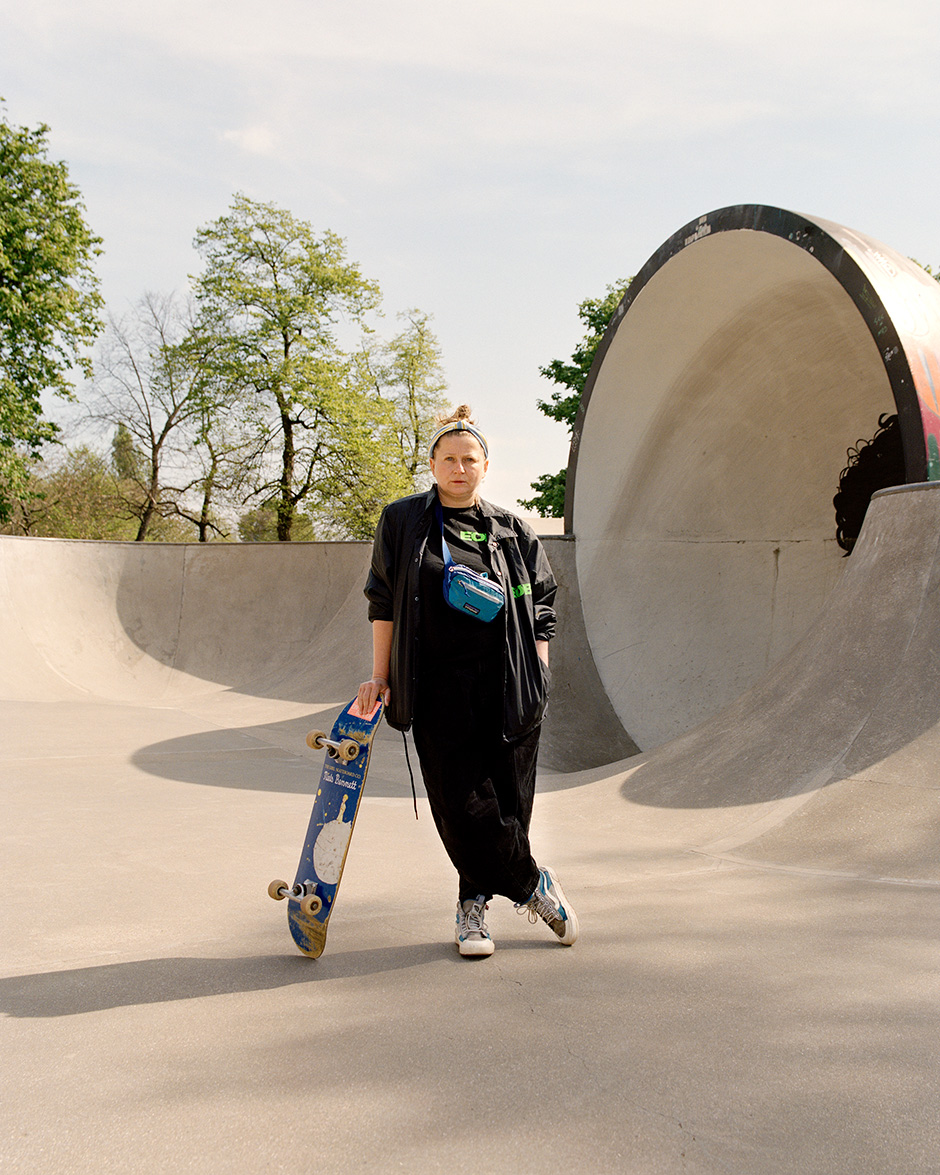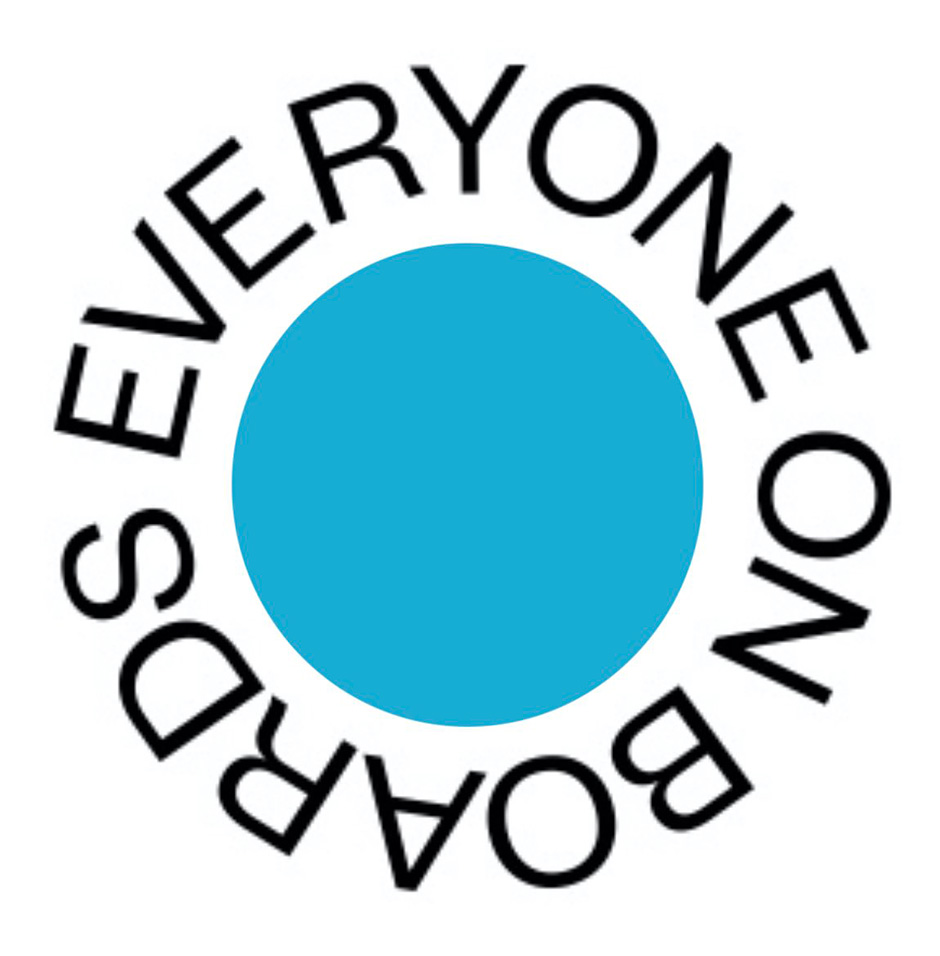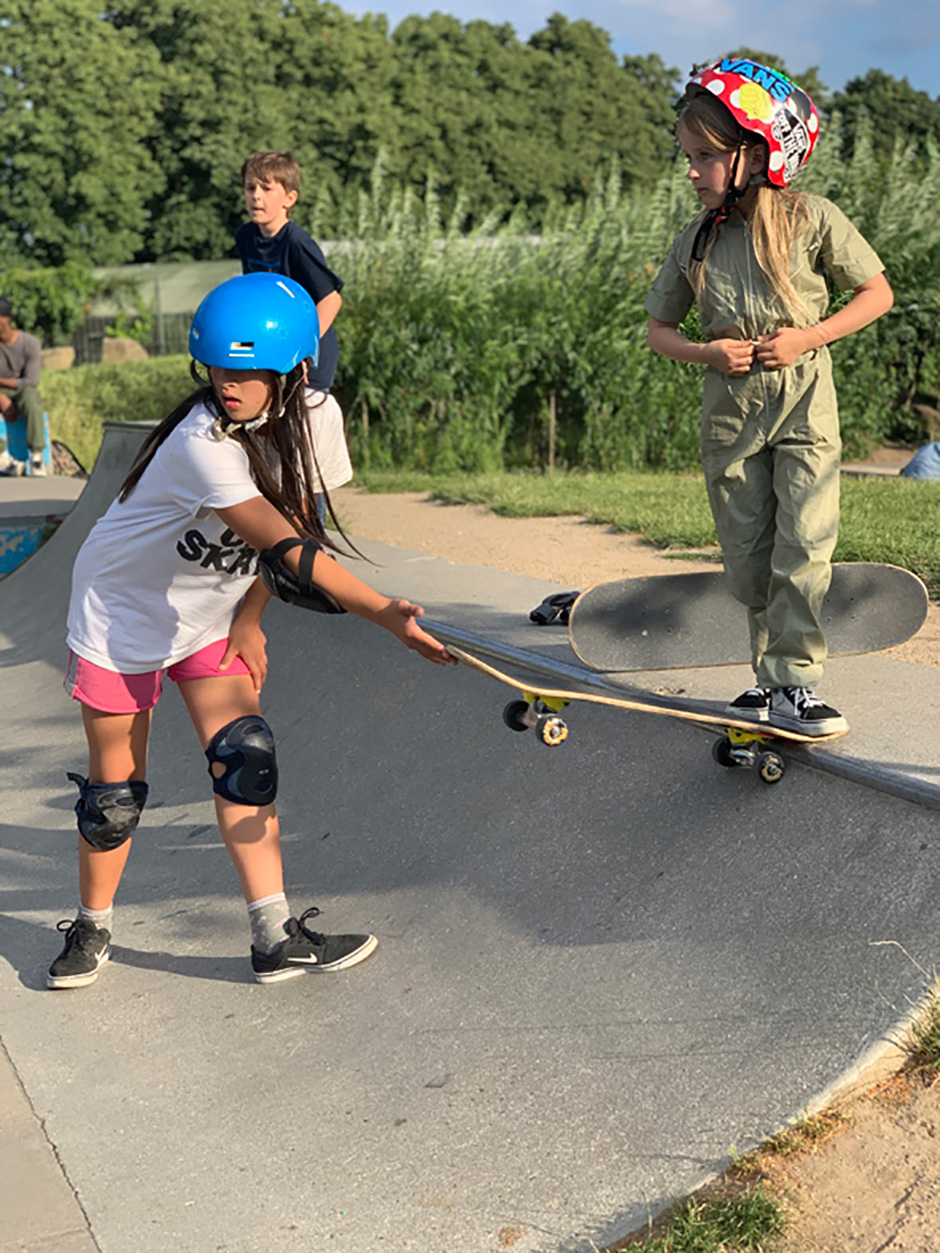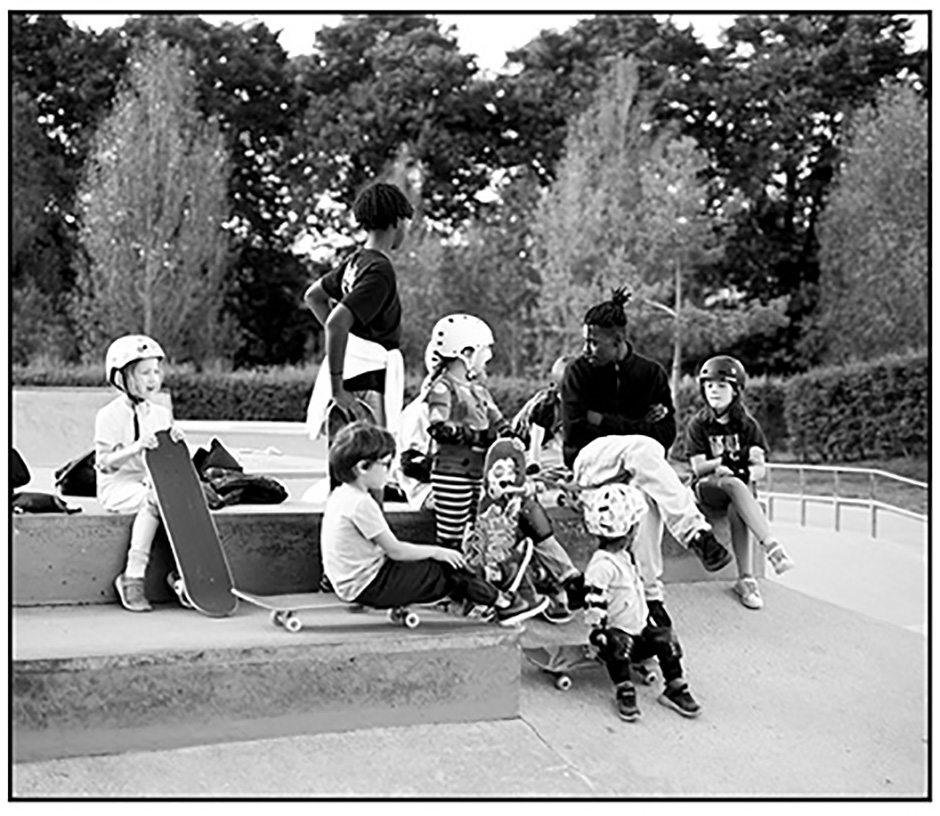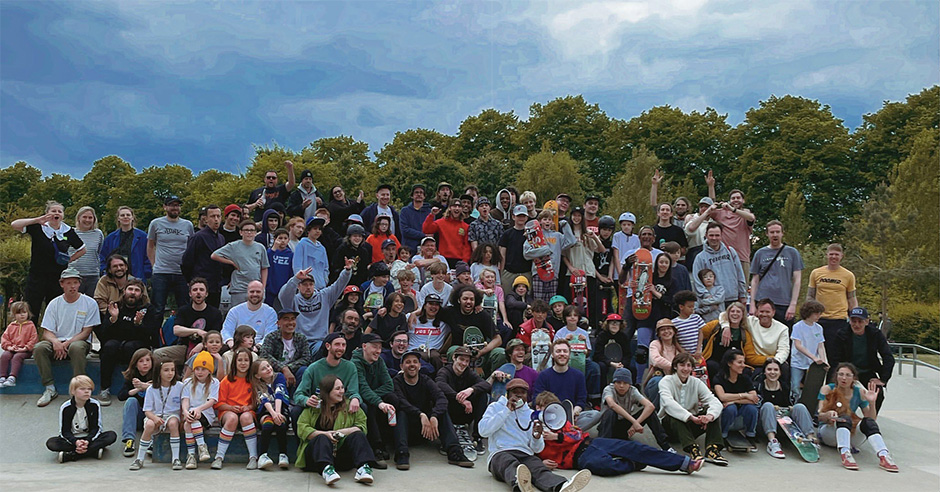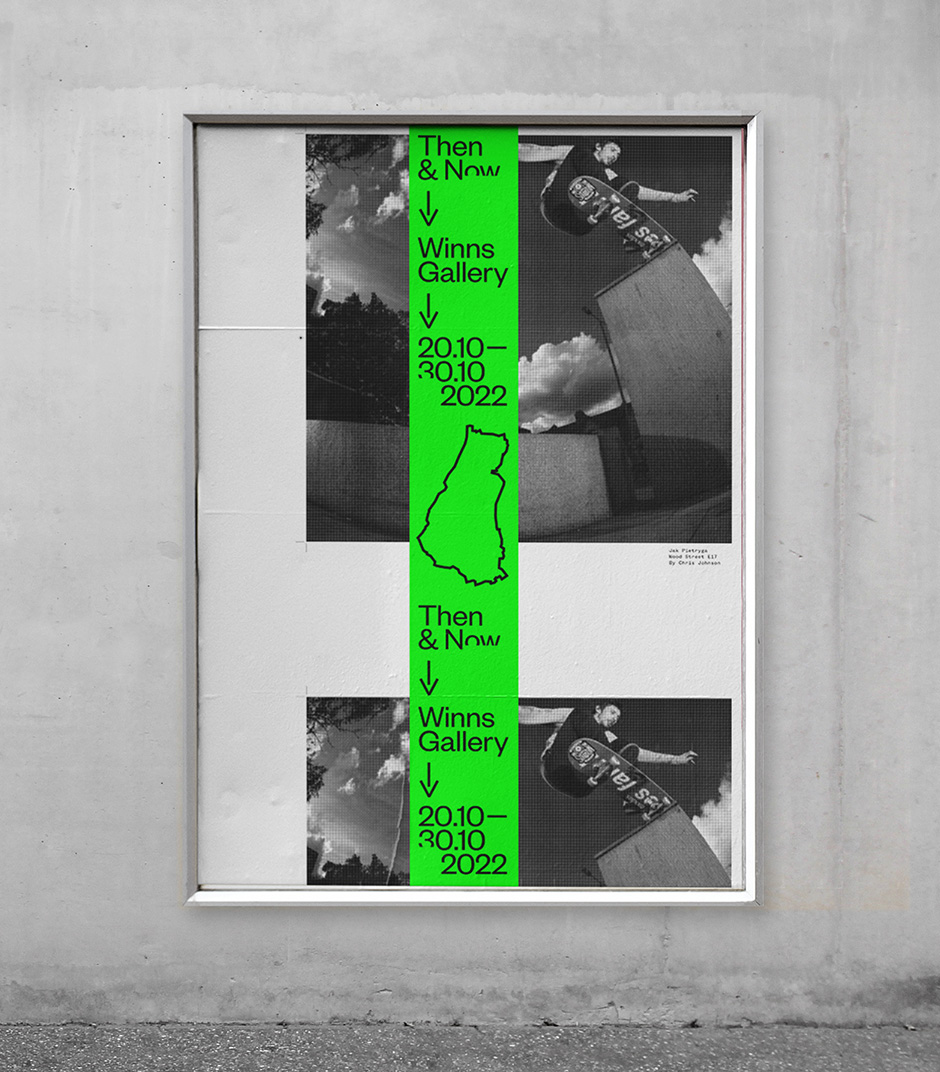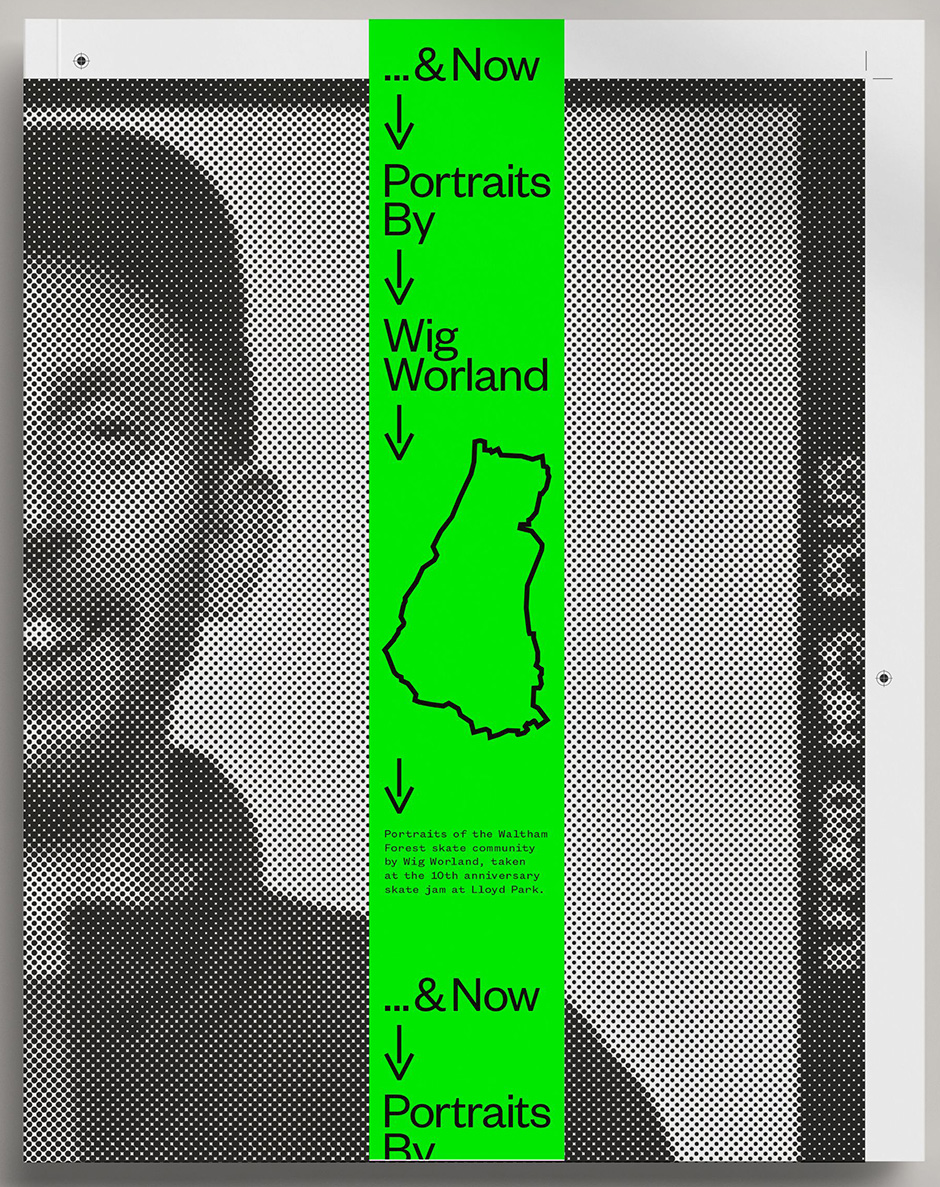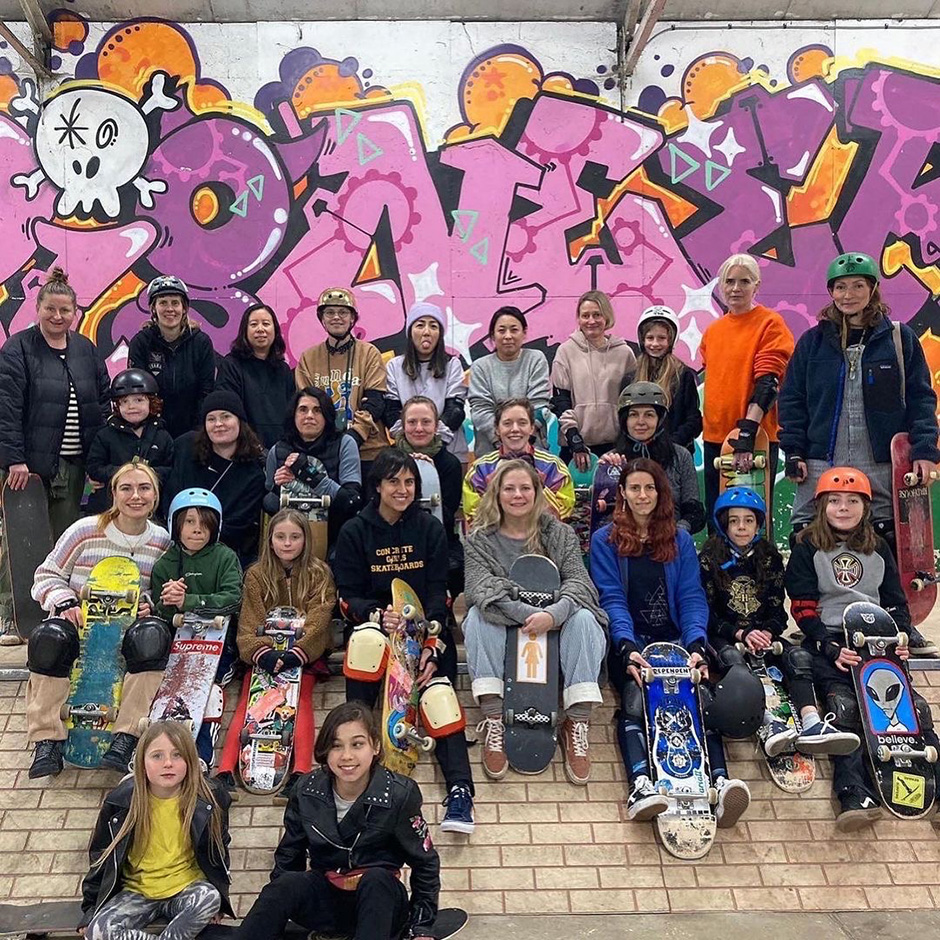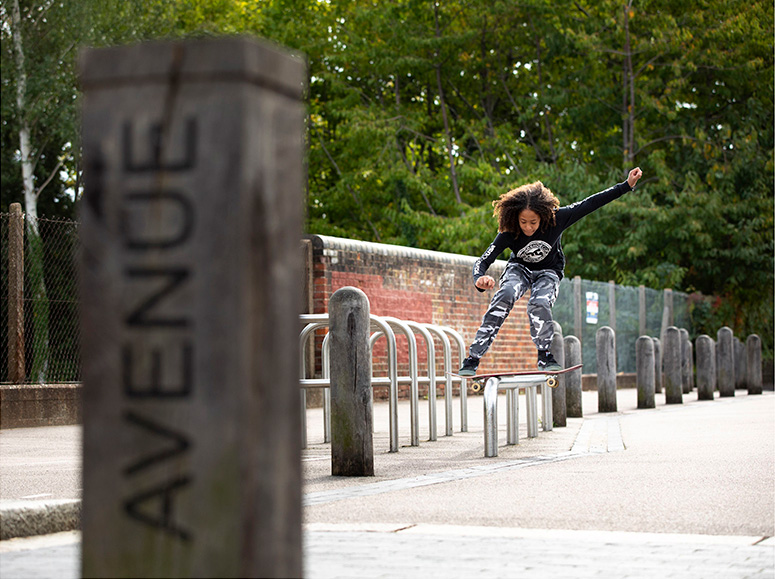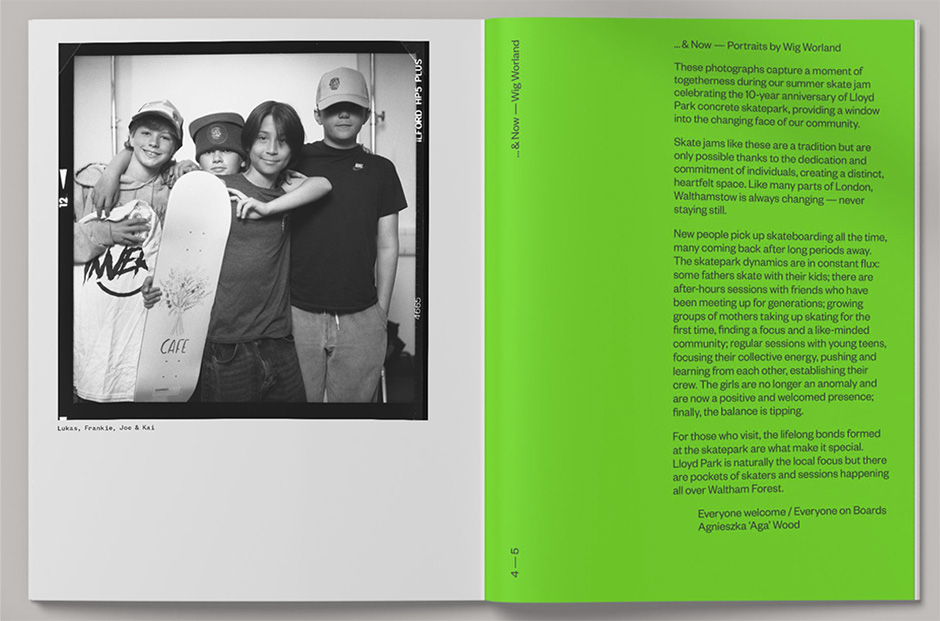This Everyone On Boards interview with Agnieszka Wood will inform you more about the incredible progress this organisation from Waltham Forest has made in a short time. We are publishing this just ahead of their Then & Now exhibition and book launch…
Words and interview by Jacob Sawyer. Agnieszka ‘Aga’ Wood at Victoria park. PH: James Arthur Allen
Everyone On Boards is a shining example of how engagement and organisation, coupled with passion and perseverance, can achieve great things for the surrounding community. It was initially born out of necessity as founder Agnieszka ‘Aga’ Wood recognised some missing infrastructure that would benefit her daughters. It has since grown into an organisation that directly benefits the immediate community through events and beyond. Since lockdown, Everyone On Boards have implemented different incentives to encourage children of all ages and backgrounds to enjoy the thing we all love and facilitate their entry into the fold.
We spoke to Agnieszka to find out more about the organisation and the Then & Now book and exhibition which is just about to launch. This project is a celebration of Waltham Forest’s most diverse and welcoming community. It reinforces the positive impact skateboarding has, and continues to have, on so many lives. This exciting next step also furthers the dialogue with the local council. We hope that this milestone will lead to an indoor facility in the borough soon becoming a reality, a possibility that remains a driving force behind the developing organisation. We hope you enjoy the following interview with Agnieszka: an inspiring tale of building momentum to create change, welcome others, and further widen the community.
How did Everyone On Boards first germinate from an idea into an organisation?
I didn’t reinvent the wheel, it was more a case of responding to the needs of the community. I grew up in the south of Poland around action sports. There was a lot of snowboarding but the skate scene was quite small. We didn’t have a skatepark at the time and there were no girls skateboarding. When I moved to London I was working in fashion and photography after having kids, I wanted to introduce them to the culture that I had enjoyed. Everyone On Boards was a direct response to community needs. I have two daughters and there wasn’t enough support out there for them. We started to discover the girls scene here, Girl Skate UK being a notable and active organisation.
In London, lots of things were happening around 2019. Living in the suburbs though with two girls there wasn’t enough immediate support or spaces for younger kids. I wanted us to enjoy the same things together. I started engaging with the local skate park to see what we could do. Lloyd Park skatepark was our local. Daniel Turner was the main pillar there who organised all the skate jams, together we started putting on more and more events. We worked in partnership with the Barbican and the local council. Everything evolved quite naturally as a community effort. We wanted to encourage young people to get more active in their local urban area. To enjoy life through outdoor activity and celebrate the culture of skateboarding
What did you initially want to achieve?
Firstly, It was a little bit selfish, I wanted to build an inspiring community for my own kids and for our generation to enjoy time in the skatepark with our kids. Then I realised there was a lack of support for local kids and we could do so many more amazing things via the culture of skateboarding. When setting up EOB as an official organisation the main aim was to give early access to skateboarding to the next generation, whatever background they are coming from.
“the main aim was to give early access to skateboarding to the next generation, whatever background they are coming from.”
Our goal was to partner with like-minded organisations to promote well-being and share the joy of skateboarding and its culture. Wider opportunity goals were to create somewhere that young people could find a safe space, borrow equipment, take part in workshops, and experience field trips. We wanted to set up a long-term volunteering scheme, extend a wide range of action sports opportunities for the young generation, and create new job opportunities.
When Covid happened we were quite lucky that local the park was still open, we created community meet-ups with free pizzas. Lots of volunteers like Olly Crockford, Zee, Tyrese, and Jennsy were helping us to teach the kids. We had skate jams, it was quite a nice time in a way. My idea was to combine skateboarding with other cultural and creative activities. I started to do more outreach and connect with the communities outside skateparks. I wanted to give visibility, representation, and encouragement to more girls at skate parks.
When the lockdown eased I realised we needed to create a sustainable model for Everyone On Boards to grow and develop. To create a bigger impact you need a good team, this was when Josephin Orving came on board. Local girls like Elena and Hannah helped as well.
“I wanted to give visibility, representation, and encouragement to more girls at skate parks.”
Drop in support during a skate session at lloyd park
Every skatepark evolves its own community. What you have created reinforces that and empowers its members.
Yes, I was observing, to build and celebrarate what was already there. Waltham Forest had the legacy already, from Chase lane in Chingford in the 80s through to Cann Hall. Each skatepark had their own identity and community. You had amazing skaters like Jak Pietryga and the Yes Fam crew. Then you had the Cann Hall crew with Josh Cox, Umar and more..
I was inspired by what House Of Vans were doing, a big brand working with different communities and crews. This was positive but taking place in central London, somewhere visible and good for the brand. When you are in the suburbs though, a local skatepark, a little village, these events are not regularly accessible. I recognised it as a great thing but not enough, I saw the gaps we needed to fill. How could we connect with the community and create opportunities? I realised that if we worked outside of brands we could create something which had more of a legacy. That’s why I set up Everyone On Boards and everything else followed.
Is there a mission that drove everything forward?
To open the first Indoor skatepark in Waltham Forest! Early on we recognised that we need a hub beyond the skatepark. There are skateparks all over the country like Lloyd Park, a focal point with local people coming and going but without a real centre. How do you engage with everyone and how do you create a legacy? Early on we saw the need for an indoor skatepark. We’re in East London and there’s nothing like that around. You see those gaps and try to figure out how to fill them and create a cross-community dialogue with local governing bodies.
“Early on we saw the need for an indoor skatepark. We’re in East London and there’s nothing like that around.”
We grew the team that we work with. It was originally based on volunteering but we realised that wasn’t sustainable. We needed to create a circular economy, a more sustainable model. We saw ways that volunteers could be enrolled into training programs leading to jobs. One of our first volunteers was Jennsy Tumba, he is now our main coach delivering provisions to youth clubs and at local skateparks. Lots of kids look up to him. We investigated every way we could create a support network. I’m still learning every day, figuring out how to respond to community needs.
Jennsy Tumba and some of his students during one of many ongoing skate sessions. PH: Myles Bailey
The main focus was always to create free early access to skateboarding and it’s culture for young people. When you are a teenager you don’t need help to find skateboarding, skateboarding finds you, but there are often situations for the younger generation where people don’t know where to start. Everyone On Boards is not a skate school, it is an organisation on many different levels. We want to engage with the cultural and creative elements of skateboarding as well. However through grants and brand partnerships we are able to deliver free skate lessons to local kids.
“through grants and brand partnerships we are able to deliver free skate lessons to local kids.”
We are able to bring kids from the local skatepark snowboarding and surfing, this is something we did quite recently. This type of organisation exists in America but we don’t have this in the UK. I’m just trying to figure out how to make it happen. These bigger projects will take us a little more time but the more exposure we have can lead to further support from outside bodies.
Incentives you have implemented like skate lessons and half-term activities definitely break down concerns many parents have about their kid skating. There’s a comfort in that structure which means more kids will try it as a result.
When you are twelve you are independent, you go to secondary school, you go to the skatepark by yourself, you are discovering skateboarding on your own with your mates. Our generation is changing things, we want to take the positive things that come from skateboarding and share them with the younger kids. With the skate sessions and lessons, what we are trying to facilitate is a safe space for the younger kids. Affordable paid skate lessons help us to raise money to offer free sessions to disadvantaged kids who may not have access to that.
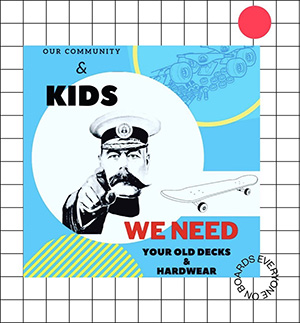 I want to enjoy skateboarding, and I want to enjoy it with my kids, my two daughters love girls night. Early access and representation is important for the next generation. I love working with local youth clubs, we work with Project Zero. We engage with different non-profit youth organisations.
I want to enjoy skateboarding, and I want to enjoy it with my kids, my two daughters love girls night. Early access and representation is important for the next generation. I love working with local youth clubs, we work with Project Zero. We engage with different non-profit youth organisations.
We recently did a program four blocks away from a local skatepark in an estate. We did the sessions there and invited the kids to free sessions at the skatepark every Thursday. We didn’t realise that for many of these kids postcodes are an issue and they won’t cross them. It’s important to introduce these things to people in their own environment.
Planting seeds is important, I’m a big advocate for sustainability. We collect old skateboards and parts and pass them on to the kids who need them.
What events are you proudest of organising?
Local skate jams, youth club engagements, the campaign for the indoor skatepark. Bringing the Betongpark ramp to Patchwork (our first indoor pop up). Our latest one where we took a minibus full of kids to the Wave to go surfing was fun. I’m proud of more or less everything because I put my whole heart into it.
Have you been able to nurture a good working relationship with the council?
Because Everyone On Boards is an official organisation you can quite often open a dialogue with the local government or other public sector bodies. Our actions speak for themselves. I’m like a conduit between the skate community and the council, it is about opening the conversation. Instead of blocking amazing skate spots, let’s create skate-friendly boroughs, this is the mission. Our up and coming exhibition is like the first indication of cross-community dialogue.
“Instead of blocking amazing skate spots, let’s create skate-friendly boroughs, this is the mission.”
The widening Waltham Forest skate community at the Lloyd Park 10 year anniversary jam
How did the Then & Now project come to life?
I believe in the power of grassroots movement. Lloyd Park and Cann Hall skateparks and other spots around Waltham Forest are focal points for skateboarders and artists from diverse backgrounds. These spaces nurture creativity and encourage integration and collaboration, they also reflect the multicultural nature of the borough. To celebrate that, I had the idea for an exhibition. A photographic and artistic journey through the skateboarding community who have occupied a significant position in youth culture for over 40 years, and developed a distinct visual language. I applied for a culture grant. The first time I was rejected as applying for grants was a totally new concept for me but I never gave up. I learned, applied again, and this year we have been successful.
Our up coming exhibition Then & Now is funded by the Make It Happen grant. The concept is a visual exploration of youth culture from the past and present through the eyes of the skateboarding community of Waltham Forest. There will be an exhibition of photographs alongside the Artists On Boards project being displayed, the book will be launched, and creative workshops will be offered. We received a pocket of money to hire the venue, print the book and put the exhibition together aided by the free support of our community which is priceless. Our main aim, the bigger picture, is to create the first indoor skatepark in Waltham Forest. This is the best platform to promote that objective.
“I was delighted when Wig Worland joined us and agreed to photograph our community…”
Four of Wig Worland’s portraits for the book. Clockwise left to right: Jak Pietryga, Nafi Rose, Daniel Turner, Oliver & Harris
Projects like this you can’t do alone. I was delighted when Wig Worland joined us and agreed to photograph our community. In May we had a skate jam at Lloyd Park skatepark and we set up a studio in the back of the gallery. I told Wig that we expected to shoot around 23 portraits but we got so hyped up that in the end I think he shot 58 portraits. This turned into the publication. It was an amazing spontaneous process. Jenna Selby gathered and photographed a few girls at skate spots in Waltham Forest which was fun as well. There are also images from the next generation, photographers like Myles Bailey and Jade Smith. Myles grew up skating Lloyds. He made a lovely book called Wake following the death of Ben Raemers. So you have two established pillars , Wig and Jenna and then Jade and Myles. They all have a different view on the skate community.
“I told Wig that we expected to shoot around 23 portraits but we got so hyped up that in the end I think he shot 58 portraits.”
For the exhibition we worked with Tijl Schneider, Matteo Fogale and Chris Christodoulou to create an identity derived from the concept and progress of time (Now & Then). We wanted to celebrate the rich history of skateboarding in Waltham Forest through a timeline. The images used on the posters and promo communication were designed to flow/scroll off the media edges, illustrating the passing of time (Then), and the entering of the present (Now). Many of the images have been treated and stylised with a halftone filter, partly to improve their appearance given the low resolution nature (often scanned from archival printed photographs), and also to amplify the DIY ethos associated with skateboarding. The strong neon ’stripe’ creates a recognisable holding device that contains key exhibition information, while the colour green provides a subtle reference to the leafy borough of Waltham Forest.
Framed exhibition poster on the streets featuring Jak Pietryga. PH: Chris Johnson
Wig Worland taking the time to photograph everyone on that day is community building in itself.
Yes, it is. Then & Now is a body of work, it’s a group show, a community effort. At the beginning I had a visual idea and a brief of what I wanted to achieve. My background is in fashion and photography. I wanted the book to celebrate skate photography as well as the impact skateboarding has had on photography as well.
Youth culture as well, how far back do the photos go?
With the photographs we had to be creative. When I first had the idea I had to research the scene and how it had evolved through the ages. I found out about the vert ramp which existed at Chase Lane in the 80s. This was self-built by local guys including a local legend called Paul Wright who built a number of ramps and appeared in RaD magazine. There was a great local scene but the ramp burned down and was replaced by mobile ramps built by the council, the soul just disappeared. It’s the story of that time period to now.
This project is almost like the first step in engaging with the wider community but bringing all of those stories together when everyone has moved around so much has been a challenge. We wanted to do something low-key while celebrating local personalities like Jak Pietryga, Morph, Kevin Parrott, Paco. Or someone like Daniel Turner, without Dan none of the skate jams would ever have happened, he is instrumental. He was the first person who welcomed me to the skatepark community and also who supported what I wanted to do and understood it.
By celebrating what was happening in the 80s through to reaching kids who are just starting you have included the breadth of the community.
Yes, it’s cross-generational. Someone like Neil who runs Yes Fam is another pillar of the community at Lloyds. He is amazing and all the kids there look up to him. He is always so helpful and friendly. Maybe someone looking at the scene there from outside won’t understand how welcoming and inclusive the community is. It could be intimidating at first but we are trying to encourage that first step.
Then & Now Book Cover featuring Jak Pietryga shot by Wig Worland
This exhibition is a community effort and I have been working with amazing people. The designer I have been working with is called Tijl Schneider, he has been alongside me on this journey. Because it is a community project and not commercial, we haven’t had to answer to any brands. This creative freedom has meant we can do what we want without following any imposed aesthetics or guidelines. We have created our own aesthetic. Everyone involved in the group show is a skateboarder, has a background in skating or their kids skate. They are all a part of the community and we want to celebrate and share the culture with different people. I just want to create a space that I want to be a part of.
That also applies to celebrating the International Day Of The Girl festival.
That was a local event and we wanted to highlight visibility and representation for young girls aged from 7- 12 years old. We wanted to celebrate the changing faces of the skate community. Representation is quite important, if they only see the guys skating at the skate park it can be intimidating. But things are changing, 80% of the people who attend our sessions now are girls. This is because I think an organised session where you know you are welcome is less intimidating. When I used to go to the girls nights at House Of Vans or Baysixty6 we all knew each other and that was only a few years ago. Now there are thousands of girls skateboarding in the UK.
“When I used to go to the girls nights at House Of Vans or Baysixty6 we all knew each other and that was only a few years ago. Now there are thousands of girls skateboarding in the UK.”
The Mothers who shred movement together and not on dawn patrol
On a tangent, as a parent what you are doing is also challenging preconceptions of what it means to be a mother. Esther Sayers spoke about this in the Senior Skateboarding article we published.
We organised the skate meet ups and Mothers Who Shred because nobody else was doing it. We were born in the 70s and there was no direct representation there although you wanted to do it. Right now why not? We have our WhatsApp group of skate mums and there are about 16 mums in it. Speaking about Esther and our schedule compared to everyone else, we have a totally different timeline. We have mums who go to the skatepark at 6 in the morning because it’s quiet. We will skate Stockwell at 9am after school drop off, or there are mums who meet at Victoria park at 7:15. It’s fascinating how skateboarding is changing and it’s exciting. It’s a place for anyone.
I grew up in a co-educational system and I don’t think things should always be girls only. However, I see my kids and they will skate more at the girl-only sessions and challenge themselves more. When they just go to the local park they are perhaps less confident. It’s complicated. Ironically I went to a MET college. There were 5 girls and 800 guys in the technical college. What I observed was that in my class when the girls were around their testosterone levels were quite low. The guys got used to the girls and didn’t feel the need to perform to impress us. But the male-dominated classes were chaos. Different systems work for the younger kids, it’s quite complex.
“It’s fascinating how skateboarding is changing and it’s exciting. It’s a place for anyone.”
On a grassroots level, it’s really all about creating safe spaces and being aware of how best to do that. Here’s an example, there was a big local skate jam and I asked the organisers when the girls runs would be. Their response was that they were welcoming girls to take part and join in the whole thing. If you’re not creating a girls heat in the midst of this testosterone-driven moment it excludes people. There were about a thousand people there and maybe twenty girls, none of them took part in the jam. It’s interesting, on one side you want to make everything equal but if there was a girls heat then more girls would be happy to join in. When there’s a huge amount of guys skating it takes some guts to get involved. It is quite fascinating observing the changing face of skateboarding.
Next generation. Kitty Joseph boardslides in Waltham Forest for Jenna Selby’s lens
Is there anything else you would like to say about the book
The book is a community-led publication. It comprises of a series of portraits taken by legendary skate photographer Wig Worland during the 10th anniversary of Lloyd Park Skatepark. It focuses on individuals of the local community involved in the Waltham Forest skate scene from the 80’s through to the present generation. The book portrays the changing faces of the skateboard scene with the aim to inspire the next generation. It was designed by Tijl Schneider.
You have involved artists in the exhibition too?
Yes we involved artists too. We want to raise funds for the indoor skatepark project. With the support of Clown Skateboards, we commissioned artists. They gave us blank decks to be painted and we approached a few artists like Experimental Jetset, Mau Mau, Angry Dan, Simon Brown, Pete Fowler, Katrina Adams, Fandangoe Kid, and Tizer. We will also showcase work by artists like Rich ‘Benny’ Hughes, Nathan Appleyard, Greg Cox, Helen Plyconic, Chris Johnson, and Andrew Hulbert. It is another excuse to engage with the extended community and open a wider dialogue.
Glimpse inside ‘Then & Now’. Photo by WIg Worland, Intro By Agnieszka Wood
Are there any current developments with the indoor skatepark?
The story was that I found a warehouse which was 8000 square foot, it was amazing. We managed to raise almost £50k but the council gave the space to an alcohol beverage company. Of course there is money in alcohol and not in skateboarding, that was a more sustainable choice for them. Planning permission, case studies, and visibility all cost money. Making the exhibition will create a visibility study about community engagement. If we raise the money we could create a proper visibility study which fits into their needs. Step by step we will make more noise.
What plans do you have for opening night?
Opening night is there to celebrate the community coming together and the effort we all put in. Kevin Parrott has made an edit made up of lots of footage including stuff from Jake Martinelli. It’s there as a creative outlet, I have more or less given people the opportunity to do whatever they want. In curatorial style we will just put it all together. Alongside the book we are printing and displaying 24 of Wig’s portraits. Everyone involved is doing this because they love skateboarding.
When will the books be available?
The book will be launched on the 20th October at the opening night and will be available through our website. The proceeds will go back into our community programs, again this self-sustaining circular economy model. This way we will be able to give free skateboarding lessons to local kids. I would like to thank Gail Dobinson, Oliver Wood, Oliver Hannan, and everyone who has supported me on this journey. For me this is just the beginning and like always EVERYONE WELCOME / EVERYONE ON BOARDS.
We would like to thank Agnieszka Wood for taking the time out to answer these questions and expand on the Everyone On Boards mission statement. Thanks also to Wig Worland for sending us the portraits, and for being the legend behind the lens that he is.
Please be sure to visit the ‘Then & Now’ exhibition at Winns Gallery, Lloyd Park, E17 5JW. Opening night is on Thursday 20th October and you can RSVP to [email protected] to attend. If you can’t make the opening night the show is on until 30/10/22.
Be sure to follow Everyone On Boards for further developments, news, and events.


